2008.07.24 10:03
Iconography, or the problem of representation
 
"Additionally, there is an exhibit of three Calder sculptures within the forecourt of the Rodin Museum. I found myself really admiring all these sculptures because I now see a 'real' virtual architecture in them."
-- 2002.11.20
So maybe there really is a Calder Museum of Virtual Architecture.
| |
2008.07.21 17:41
bored with modern & contemporary, yet?
http://en.wikipedia.org/wiki/Modernist_literature
2008.07.21 09:02
bored with modern & contemporary, yet?
"What Stein discovered was a writing style that celebrated its grammatical mistakes. In her most radical prose, she managed to make us conscious of all the linguistic work that is normally done unconsciously. We notice the way verbs instantly get conjugated (even irregular verbs), the way nouns naturally become plural, and the way we amend articles to fit their subjects. Stein always said that the only way to read her writing was to proofread it, to pay acute attention to all the rules she violates. Her errors trace the syntactical structures we can't see, as our "inside becomes outside."* Stein showed us what we put into language by leaving it out."
* This isn't as strange a method as it might seem. Ludwig Wittgenstein hit upon a similar method for his philosophy, which, like Stein's writing, was interested in the uses of language to the exclusion of almost everything else. Wittgenstein once said that he worked by "mak[ing] a tracing of the physiognomy of every [philosophical] error." Only by mapping out mistakes could he see how best to proceed. Samuel Beckett also subscribed to Stein's literary approach. "Let us hope that a time will come," Beckett wrote, "when language is most efficiently used where it is being misused. To bore one hole after another in it, until what lurks behind it--be it something or nothing--begins to seep through; I cannot imagine a higher goal for a writer today."
Jonah Lehrer, Proust was a Neuroscientist (2007), p. 164.
Here we have 'modernist' thinking.
Alberti's thinking appears more Platonic.
Michelangelo's thinking appears more Aristotelian.
2008.07.16 18:09
bored with modern & contemporary, yet?
Ah, the altar altercation!
"But in the thirty years between Alberti and Francesco di Giorgio, with centralized planning coming into its own, controversies flared which are faithfully mirrored in Francesco's text. These controversies were, however, not concerned with the liturgical suitability of centralized churches as such--which nobody seemed to have doubted--but with the question whether the altar should be placed at the periphery or in the centre."
2008.07.16 17:25
bored with modern & contemporary, yet?
"In the past Eisenman has often been criticized for his reliance on concepts from outside of architecture. With this analytical work he declares explicitly that it is buildings themselves that are the source of ideas in architecture, and not applied philosphical concepts from outside the discipline"
--Stan Allen, "Eisenman's Canon: A Counter-Memory of the Modern" in Ten Canonical Buildings 1950-2000.
Leave to Allen and Eisenman to now 'declare' what has otherwise always been one of architecture's most self-evident features.
Eyes which do not see, indeed.
The first chapter of Wittkower's Architectural Principles in the Age of Humanism is entitled "The Centrally Planned Church and the Renaissance". Good stuff about the theoretical origins of the centrally planned church and its practice; not much about any "true debate" nor popes.
beginning of the last paragraph:
The new interpretation of religious architecture was soon to be challenged. Carlo Borromeo in his Instructionum Fabricae ecclesiasticae et Superlectilis ecclesiasticae Libri duo of about 1572, applied the decrees of the Council of Trent to church building; for him the circular form was pagan and he recommended a return to the 'formam crucis' of the Latin cross.
| |
2008.07.16 15:57
bored with modern & contemporary, yet?
Are you sure you mean "central plan versus the greek cross" because the (so-called) Greek cross was the centralized plan. I think you mean the Latin cross versus the Greek cross.
2008.07.16 15:13
bored with modern & contemporary, yet?
Vitruvius's book De architectura was rediscovered in 1414 by the Florentine humanist Poggio Bracciolini. To Leon Battista Alberti (1404-1472) falls the honour of making this work widely known in his seminal treatise on architecture De re aedificatoria (ca. 1450). The first known edition of Vitruvius was in Rome by Fra Giovanni Sulpitius in 1486. Translations followed in Italian (Como, 1521), French (Jean Martin, 1547 [10], English, German (Walter H. Ryff, 1543) and Spanish and several other languages.
On June 25, 1496 at the age of twenty-one, Michelangelo arrived in Rome.
Opposite it in the south transept is the Sagrestia Nuova (New Sacristy), begun in 1520 by Michelangelo, who also designed the Medici tombs within. [Michelangelo's first substantial architectural work.]
Architecture books were still fairly new and rare in Michelangelo's time, and they pretty much covered the basics (and anyone who could read, could grasp the basics). The greater architecture 'texts', however, were buildings themselves, and here the 'rules' are legion. I wouldn't say Michelangelo was intuitive in looking at existing architecture, rather sculpturally observant (and them sculpturally imaginative). Remember too, the most celebrated ancient columns in Renaissance Rome looked like this

--hardly your 'basic'.
Another example of the sculpturally observant-sculpturally imaginative:
Michelangelo himself wrote of how the newly discovered Belvedere Torso was a great inspiration for him. And now see how the ignudi of the Sistine Chapel ceiling represent the potential Michelagelo saw in the Belvedere Torso.
| |
2008.07.15 21:12
bored with modern & contemporary, yet?

Picasso wasn't necessarily breaking any rules here, but he was being somewhat improper. What this work tells me is that Picasso recognized a sculptural potential in a bicycle seat and handle that when combined (improperly, in a way not done before) generated a masterpiece. I get the same sense when I look at Michelangelo's architectural detailing. Rather than simply breaking the rules, he saw potential in architectural details that others before him hadn't seen before, and he produced many improper combinations and many unprecedented details.
e.g., Porta Pia
Perhaps Michelangelo didn't even see classical architecture as a set of rules, rather a set of potentials. (And perhaps language/grammer too might not be seen as a set of rules, but rather a set of potentials).
2008.07.15 16:16
bored with modern & contemporary, yet?
...there really is no evidence that Michelangelo knew the rules so well that he thus also knew best how to break them. That logic is more indicative of a latter-day, wishful-thinking, pedagogical explanation.
Michelangelo was more of a reluctant architect; architectural commissions were generally not something he sought. Sculpture was his real passion, and I suspect it was his sculptor's eye that really led him to use/design architectural moulding the way he did.
2008.07.14 17:17
Is there a literal term for this design?
mall : A shady public walk or promenade.
esplanade : A flat open stretch of pavement or grass, especially one designed as a promenade along a shore.
| |
2008.07.14 17:02
bored with modern & contemporary, yet?
...and yet much of Michelangelo's architecture was all about the improper use of mouldings...
2008.07.14 12:52
bored with modern & contemporary, yet?
I've come to think that one of Jay's greater talents was his creative (and sometimes even original) use of limited resources. Being creative with limited resources might just be a very desirable talent again.
2008.07.14 12:27
bored with modern & contemporary, yet?
For many years now, I remain inspired by the design and detailing work of William Jay. For example, the interior mouldings of the Telfair House (now Telfair Museum) are impressive in scale yet possess a simple elegance. When studied closely, however, you discover they are not carved or milled, but rather (imaginatively) composed of a variety of typical (even today) moulding pieces. And when you find curved doors that match the curved wall that they are in, you soon learn that Jay employed local shipbuilders as craftsmen. Made me realize that fine detailing wasn't necessarily something difficult.
2008.07.14 10:06
bored with modern & contemporary, yet?
"Then I thought, might it not be interesting if homes were treated/designed like BIG BOX stores."
It could well be argued that the Villa Savoye is a fitting representation or acme even of the paradigm shift in residential architecture toward overall minimalism. The skeleton of a minimalist building is even more minimal (or see Farnsworth House). Then came the decorated shed with minimalist decoration. And in the virtual present gemmating decorated sheds infringing upon minimalist remains.
2008.07.14 08:06
bored with modern & contemporary, yet?
gemmating decorated shed/skeleton of paradigm shift: infringement complex II...
|